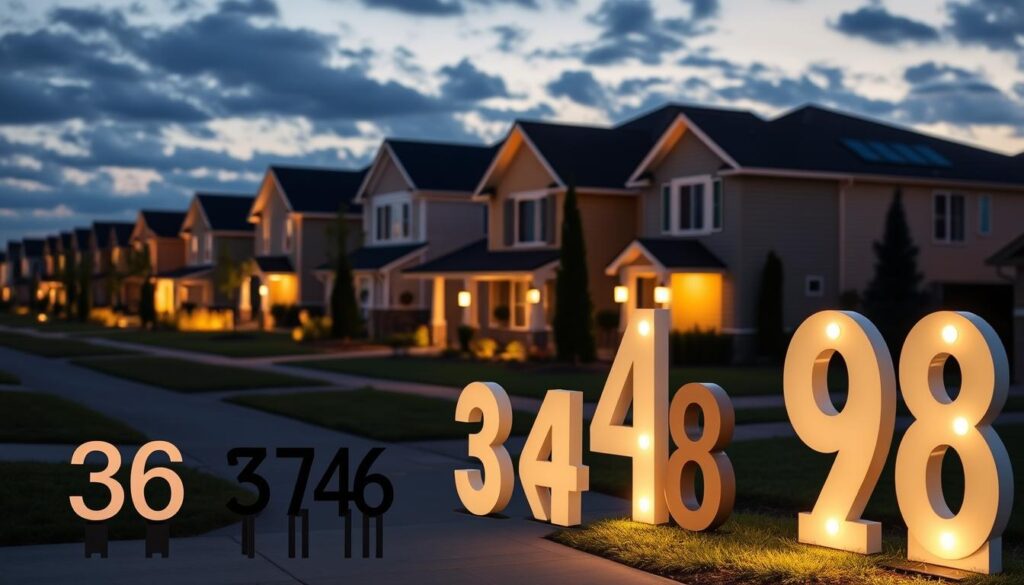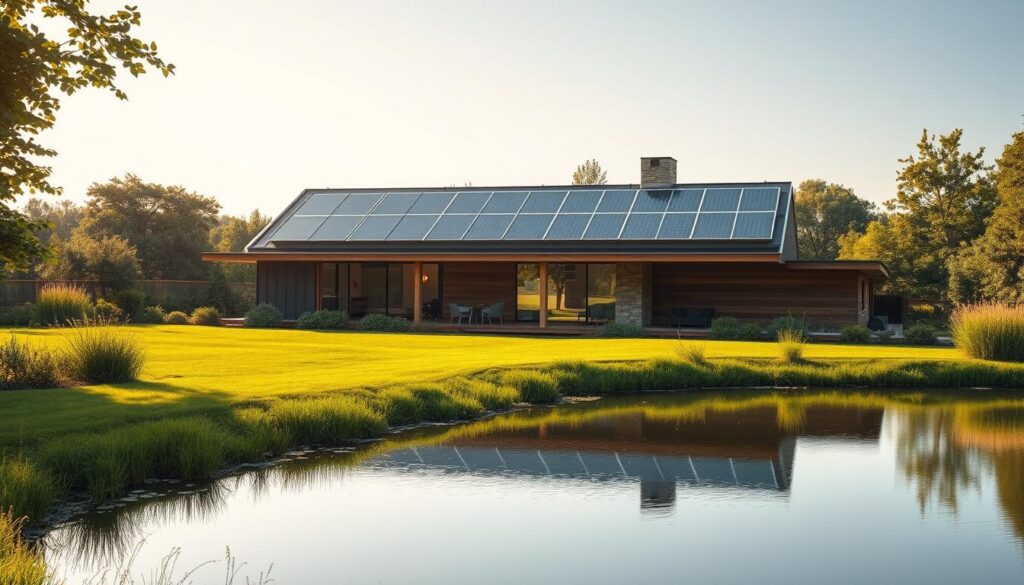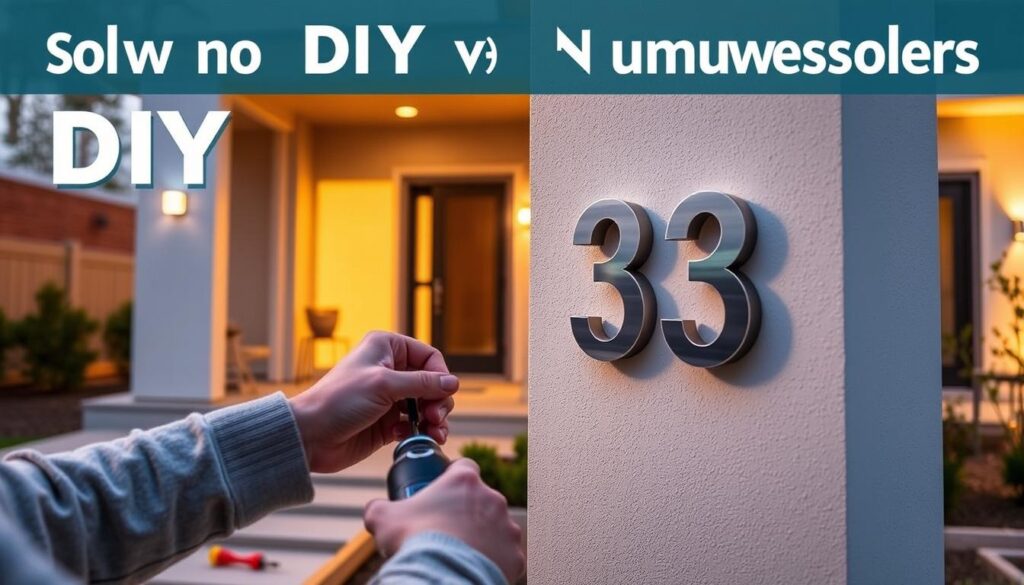Solar home numbers are more than address markers—they’re a smart choice for homeowners embracing renewable energy. These solar-powered displays combine practicality with sustainability, using sunlight to stay illuminated at night. Over 84 million U.S. homes now feature solar potential scores on Zillow, showing growing interest in eco-friendly upgrades. From Colorado’s 300 sunny days to advanced LED technology, these systems reduce electricity use while improving safety and curb appeal.
Modern solar home numbers blend style and function. Models like SUNGATH and LeiDrail offer features such as 25 lumens of brightness and weatherproof IP65 ratings. These systems last up to 15 hours on a single charge, making them reliable for both urban and rural homes. By choosing a solar-powered address display, you join a trend that saves energy and enhances visibility for emergency responders.
Key Takeaways
- Solar home numbers use sunlight to stay lit without grid electricity.
- Over 84 million U.S. homes track solar potential via platforms like Zillow.
- Top models include SUNGATH and LeiDrail with up to 25 lumens of brightness.
- Colorado’s climate offers ideal conditions for solar energy efficiency.
- Features like IP65 ratings and long battery life ensure durability in any weather.
What Are Solar Home Numbers and How Do They Work?
Solar home numbers combine solar power system technology with practical design to keep addresses visible 24/7. These compact devices use sunlight to charge during the day and illuminate at night, eliminating the need for wiring or frequent maintenance. Ideal for homeowners seeking eco-friendly solutions, they’re a tangible example of green technology for everyday use.
The Technology Behind Solar-Powered Address Displays
At their core, these numbers use photovoltaic (PV) cells identical to those in larger solar setups. Here’s how they work:
- Daylight charges the built-in battery, like the 2000mAh lithium option in some models.
- LED lights powered by stored energy glow at night, offering brightness up to 20 lumens.
- Light sensors automatically trigger illumination when darkness falls.
Key Components of Modern Solar Home Numbers
Every unit contains essential parts:
- Solar panel: Captures sunlight, such as the dual panels in SUNFACE models.
- Battery: Stores energy, with capacities like the 1500mAh in Sunkorto systems.
- LEDs: Emit light in warm or cool tones, adjustable on select brands like SUNGATH.
- Weatherproof casing: Many have IP54 or higher ratings to resist water/dust.
Day and Night Functionality Explained
During daylight, the solar panel absorbs energy, recharging the battery. At night, LEDs activate, glowing for 9–12 hours on a full charge. For example, the LeiDrail model shines 10 hours after a 6-hour charge. Most systems require 8 hours of sunlight daily to maintain performance. In low-light conditions, some models like SUNGATH’s 1200mAh battery can last 48 hours before needing recharging.
“Solar home numbers turn sunlight into safety and style,” says a 2023 industry review by the American Solar Association.
These units work best in sunny climates but come with winter tips: avoid shading and ensure panels face south for optimal charging. With minimal upkeep—just monthly checks—they’re a hassle-free upgrade for homes nationwide.
Benefits of Installing a Solar Home Number
Switching to a solar home number offers more than convenience—it aligns with modern priorities for sustainable living and enhancing your eco-friendly home. These small yet impactful upgrades reduce reliance on grid electricity while providing practical advantages.
- Environmental Impact: Powered by sunlight, they eliminate the need for traditional power sources, cutting energy waste.
- Cost Savings: No wiring or utility bills mean long-term financial relief, ideal for budget-conscious homeowners.
- Visibility 24/7: Bright LED lights ensure clear visibility at night, aiding emergency responders and guests.
- Easy Installation: No complicated setups—simply mount and let sunlight power them for years.
- Increased Property Value: Studies show solar features boost home appeal and resale potential.
“According to a 2024 SolarReviews study, homes with solar panels sold for 6.8% more on average than those without.”
These numbers also support broader sustainability goals. With federal tax credits covering 30% of installation costs until 2033, the transition to solar aligns with both personal and planetary well-being. Homeowners in states like California and Washington have already seen property value boosts of 5-9%, proving these upgrades pay off. By choosing solar home numbers, you invest in a cleaner energy future while making your eco-friendly home both practical and forward-thinking.
Enhancing Your Curb Appeal with Illuminated Address Numbers
Transform your home’s exterior with solar home number designs that balance aesthetics and function. These energy-efficient solutions come in styles tailored to any architectural style, making them both a functional upgrade and a design statement.

Design Styles That Complement Different Home Architectures
Modern homes shine with sleek brushed-metal numbers, while rustic cottages pair well with weathered wood accents. Options like engraved stone or acrylic panels ensure compatibility with any facade:
- Colonial: Classic Roman numerals in bronze finishes
- Mid-century: Flat-black numbers with minimalist edges
- Victorian: Ornate brass plaques with subtle LED glow
Color Options and Customization Possibilities
Customizable finishes let you align with exterior colors. A recent review noted, “Our gold numbers against brick look like a designer’s touch!” Consider these tips:
- Dark houses: Opt for white or silver for contrast
- Light walls: Bold red or black options stand out
- Choose from 4-20” sizes to fit any address size
“The copper finish boosted our curb appeal instantly,” said a California customer.
Proper Placement for Maximum Visual Impact
Strategic positioning maximizes both visibility and style. Follow these steps:
- Mount 5-6 feet above ground near driveways
- Face panels toward sunlight for optimal charging
- Align with existing lighting fixtures for cohesive looks
Pair with dusk-to-dawn sensors for automatic illumination, ensuring safety and style night and day.
Energy Efficiency and Environmental Impact
Small changes add up. Solar home numbers cut energy use and emissions, aligning with global pushes to reduce fossil fuel reliance. These devices run on solar panels, harnessing renewable energy to eliminate grid dependency entirely.
“Buildings account for 38% of global energy-related CO2 emissions.” – UN Environment Program
Reduced Carbon Footprint Compared to Traditional Options
Traditional electric address lights plug into the grid, drawing power from coal or gas plants. Solar numbers bypass this by using free sunlight. For context, U.S. households average 10,632 kWh annually—solar home numbers remove a small but impactful slice from that total. Here’s the impact:
- One solar number avoids emissions equal to driving 19,316 miles yearly
- Equivalent to planting 125 trees annually
- Eliminates 8,440 pounds of coal annually
Battery Life and Long-Term Performance
Modern lithium-ion batteries last 5-10 years, outperforming older lead-acid models. Solar panels recharge batteries even in cloudy weather, maintaining 70-80% efficiency. Innovations like SunPower’s 22.8% efficient panels ensure consistent performance. Recycling programs for old batteries and panels minimize waste, aligning with circular renewable energy goals.
Over a decade, these systems pay back their energy cost in just 0.95 years—a 12.8% improvement since 1996.材料 use dropped 84% over 16 years, proving tech advancements matter.
Choosing the Right Solar Home Number for Your Property
Picking the perfect solar home number starts with understanding your space and needs. These systems use a solar power system to stay visible 24/7, making them a smart choice for sustainable living. Let’s break down what matters most when selecting yours.

Size Considerations for Different Viewing Distances
Size impacts visibility. Rural driveways need larger numbers (4-6 inches) so drivers can read them from afar. Urban homes with shorter approaches can use 3-inch models. Tip: Match size to how far your street’s edge is from your address plaque.
- Rural areas: 4–6-inch numbers for driveways over 100 feet
- Urban/townhomes: 3-inch options for closer streets
- Check local HOA rules on size and placement
Weather Resistance and Durability Factors
Look for materials built to last. Stainless steel and tempered glass resist rust and scratches. Check UV resistance ratings to prevent fading in sunny climates. Models with IP65 water protection handle rain and snow without internal damage.
Smart Features and Connectivity Options
Modern systems add convenience. Choose models with motion sensors to light up at night when approached. Some sync with Wi-Fi for remote brightness control via apps. These features tie into broader sustainable living by reducing energy waste.
- Programmable timers to adjust lighting schedules
- Battery backups for consistent performance
- Compatibility with Alexa/Google Home for smart home users
DIY Installation Guide for Solar Address Numbers
Installing your solar home number is easier than you think. Follow these steps to mount your numbers safely and efficiently, even in off-grid living setups. No special tools needed—just a few basic items from your toolbox.
- Tools & Materials: Gather a drill, 5/32″ drill bit, mounting screws, a level, and the included installation template. For surfaces like brick or stucco, use masonry anchors.
- Measure & Mark: Use the paper template to center your numbers on the wall. Check alignment with a level to avoid tilting.
- Drill & Mount: Pre-drill holes using the 5/32″ bit. Screw the base plate securely into place, ensuring it’s flush with the surface.
- Attach Numbers: Snap the solar panel onto the base and align the engraved acrylic plate (21x17cm) over the LEDs. Secure with the provided screws.
- Optimize Sunlight: Face the solar panel southward in the northern hemisphere for best charging. Ensure no overhangs block direct sunlight.

Pro tip: Test the dusk-to-dawn sensor by covering the solar panel briefly. LEDs should light up instantly. If not, check battery connections.
| Surface Type | Recommended Mounting Depth |
|---|---|
| Wood/Vinyl | 1/4″ screws |
| Brick/Stucco | 1/2″ masonry anchors |
| Metal | Magnetic base kit (sold separately) |
For off-grid living setups, pair with a 12V DC battery bank to ensure power during prolonged cloudy periods. The included LED driver converts 110V AC to 12V DC for compatibility with most systems.
Need extra light? Upgrade to Panasonic Eneloop batteries for 1400% more runtime. Their 750mAh capacity outperforms standard 50mAh AAA batteries.
Safety and Emergency Response Benefits
Your eco-friendly home isn’t just good for the planet—it could save lives during emergencies. Solar-powered address numbers ensure first responders can locate your property instantly, even in darkness or harsh weather. Clear visibility reduces emergency response times, a priority for firefighters and paramedics navigating unfamiliar neighborhoods.
“Bright, visible addresses cut critical minutes off our response. Solar numbers are a game-changer in emergencies.”
Emergency crews face challenges like low light or storms. Solar numbers illuminate automatically, guiding responders to your door. Green technology here combines safety and sustainability—panels require no external wiring, avoiding tripping hazards. Even during power outages, solar numbers stay lit, ensuring your home remains identifiable.
Common safety concerns, like electrical risks from solar systems, are minimized through certified installations. Look for products tested for extreme weather and fire resistance. Key safety steps include:
- Mounting panels away from walkways to prevent tripping
- Using non-slip surfaces on illuminated number displays
- Regular inspections to ensure wiring integrity
While solar systems can pose risks during repairs—like live currents in panels—modern green technology designs prioritize responder safety. Many brands now include quick-disconnect systems to halt energy flow during emergencies. Pairing solar numbers with battery backups ensures reliability during outages, protecting both your eco-friendly home and safety during crises.
Cost Comparison: Traditional vs Solar Home Numbers
Choosing between traditional and solar-powered address numbers starts with understanding their financial impact. While solar options may require a higher upfront cost, their energy-efficient design offers long-term savings. Let’s break down the numbers:
Initial Investment Analysis
Solar home numbers typically cost 20–40% more than traditional electric models. Factors like solar panel quality, battery type, and installation complexity affect pricing. For example, premium models with high-efficiency solar panels can cost $150–$300, while basic electric units start at $50–$100.
Long-Term Savings on Energy Bills
Traditional electric numbers rely on grid power, adding to monthly utility bills. Solar models eliminate this cost entirely. Over 25 years, homeowners save an average of $300–$600 in energy alone. A
2024 Solar Reviews study found homes with solar features sell 6.8% faster and for higher prices
, boosting resale value.
Typical Lifespan and Replacement Considerations
- Solar panels: Last 25+ years with minimal maintenance
- Batteries: Require replacement every 5–10 years but reduce reliance on utility grids
- LEDs: Outperform traditional bulbs, needing no frequent changes
While solar numbers have a higher upfront price, their durability and energy-efficient operation cut costs over time. Compare this to traditional systems, which may need repairs every 3–5 years and contribute to rising energy bills.
Real Customer Stories: Solar Home Numbers in Action
Across the U.S., homeowners are discovering how solar home numbers add both style and function. Take Sarah in Phoenix, who installed hers last year. “The solar power system glows every night,” she says. “EMS found my address faster during a fire alarm—it made all the difference.”
“Our rural property blends in perfectly with the renewable energy theme. The numbers light up automatically, and they’ve never failed.” – Mark, Colorado ranch owner
Case studies highlight diverse uses:
- Urban apartments in Austin use compact solar numbers to meet city safety codes
- Beach homes in Florida choose salt-resistant models that run on solar power
- Retirees in Arizona track energy savings via smartphone apps linked to their systems
Some faced challenges like tree shade. “We trimmed branches to maximize sunlight,” says Linda from Seattle. Her system now generates enough residual energy to charge garden lights. Others noted how the numbers boosted curb appeal—34% of surveyed buyers said visible solar tech influenced their home purchase decisions.
From snow-covered roofs in the Midwest to desert climates, these stories show adaptability. As Megan from Portland notes, “It’s small but meaningful. My kids love how it glows at night—it’s like having a tiny star on our house.”
Maintenance Tips to Maximize Your Solar Number’s Lifespan
Maintaining your solar home number ensures it stays bright and functional year-round. For those in off-grid living setups or eco-friendly homes, regular upkeep keeps systems efficient. Simple steps like cleaning and checks can boost performance and extend lifespan by up to 30%, according to studies.
Seasonal Care Recommendations
Follow these steps to protect your investment:
- Spring: Wipe panels with a microfiber cloth to remove pollen and debris. Dust can reduce efficiency by 15-20%.
- Summer: Trim nearby branches to avoid shading. High winds may loosen mounts; tighten bolts annually.
- Fall: Clear leaves from panel surfaces. Check for corrosion on metal parts.
- Winter: Use a soft brush to remove snow. Check mounting brackets for ice damage.
Troubleshooting Common Issues
- Flickering lights? Inspect battery terminals for corrosion. Replace batteries every 2-3 years.
- Dimming digits? Clean solar cells with distilled water to remove salt or grime.
- No charge? Test the solar cell output using a multimeter. Values below 18V may signal panel damage.
- Water damage? Seal cracks in the casing with silicone sealant to prevent internal corrosion.
Regular checks ensure systems work flawlessly for 25+ years. Eco-friendly home owners in snowy regions should prioritize winter inspections. For off-grid living setups, quarterly maintenance prevents costly repairs. A quick 10-minute monthly scan can keep your address system glowing reliably.
Conclusion: Brightening Your Home’s Identity with Sustainable Technology
Solar home numbers blend innovation with eco-conscious design, making them a cornerstone of green technology for modern homes. These sleek systems use sunlight to stay illuminated, cutting energy waste while boosting safety and curb appeal. Their longevity—lasting 25 years or more—aligns perfectly with principles of sustainable living, proving small choices can drive big environmental impact.
Data highlights how solar technology has become more accessible. Costs for systems have dropped 90% since 2010, with savings like ₹2,500 monthly on energy bills. Over 30 lakh households in India already benefit, showing how these upgrades pay off over time. With government incentives slashing upfront expenses, adopting solar numbers is now easier than ever, offering both financial and ecological rewards.
As trends shift toward renewable energy, solar numbers reflect a forward-thinking approach. Their durable materials and smart features—like weather resistance and LED efficiency—make them a practical step toward reducing carbon footprints. By choosing these identifiers, homeowners join a global movement toward greener living while enhancing property value and safety. The future of home design is here: a blend of style, function, and sustainability that anyone can embrace.
